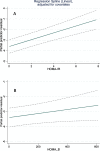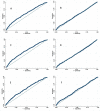Are HOMA-IR and HOMA-B good predictors for diabetes and pre-diabetes subtypes?
- PMID: 36788521
- PMCID: PMC9926772
- DOI: 10.1186/s12902-023-01291-9
Are HOMA-IR and HOMA-B good predictors for diabetes and pre-diabetes subtypes?
Abstract
Background: To investigate the association between the Homeostasis Model Assessment of Insulin Resistance (HOMA-IR) and Homeostasis Model Assessment of Beta-cell function (HOMA-B) with the incidence of diabetes and pre-diabetes subtypes.
Methods: A total of 3101 normoglycemic people aged 20-70 years were included in the 6-year follow-up study. Multinomial logistic regression was used to calculate the incidence possibility of isolated Impaired Fasting Glucose (iIFG), isolated Impaired Glucose Tolerance (iIGT), Combined impaired fasting glucose & impaired glucose tolerance (CGI), and Diabetes Mellitus (DM) per standard deviation (SD) increment in HOMA-IR and HOMA-B in the crude and multivariable model.
Results: In the multivariate model, an increase in one SD change in HOMA-IR was associated with a 43, 42, 75, and 92% increased risk of iIFG, iIGT, CGI, and DM, respectively. There was a positive correlation between the increase in HOMA-B and the incidence of iIGT; however, after adjusting the results for metabolic syndrome components, it was inversely correlated with the incidence of iIFG [Odds Ratio = 0.86(0.75-0.99)].
Conclusions: HOMA-IR is positively correlated with diabetes and pre-diabetes subtypes' incidence, and HOMA-B is inversely correlated with the incidence of iIFG but positively correlated with iIGT incidence. However, none of these alone is a good criterion for predicting diabetes and pre-diabetes.
Keywords: Diabetes; HOMA-B; HOMA-IR; Impaired fasting glucose; Impaired glucose tolerance; Prediabetes; Prediabetic state.
© 2023. The Author(s).
Conflict of interest statement
The author(s) has/have no competing interests to declare.
Figures



References
MeSH terms
Substances
LinkOut - more resources
Full Text Sources
Medical

